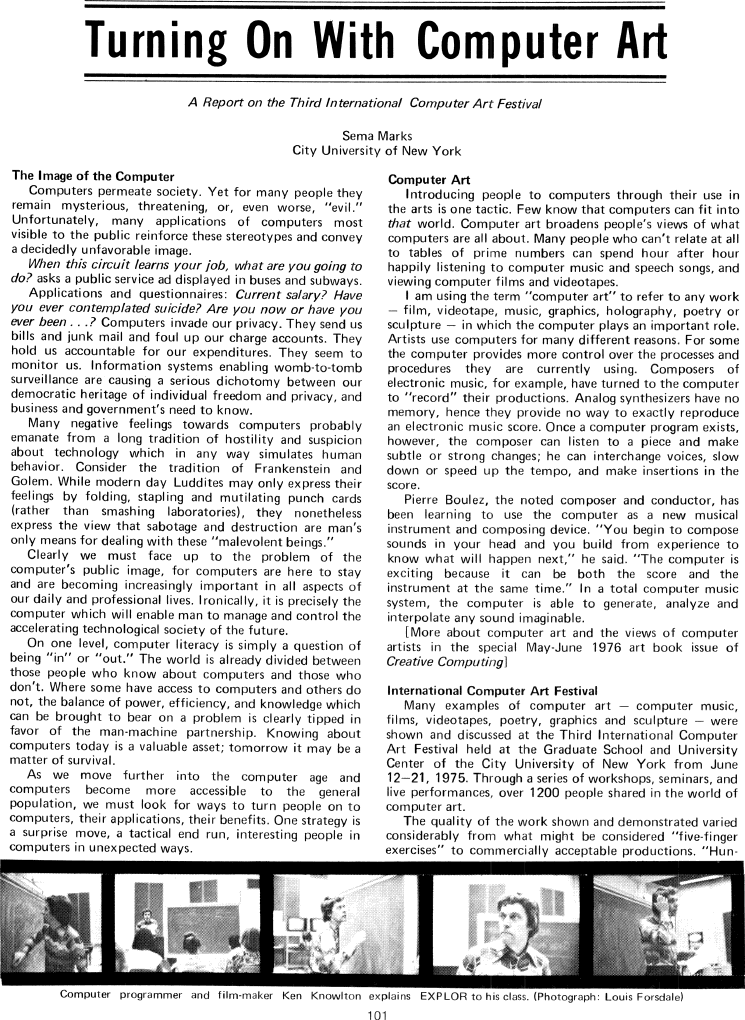The Best of Creative Computing Volume 1 (published 1976)
Turning On With Computer Art (Report on the Third International Computer Art Festival)

Turning On With Computer Art
A Report on the Third lnternational Computer Art Festival
Sema Marks
City University of New York
The Image of the Computer Computer Art
Computers permeate society. Yet for many people they
remain mysterious, threatening, or, even worse, "eviI."
Unfortunately, many applications of computers most
visible to the public reinforce these stereotypes and convey
a decidedly unfavorable image.
When this circuit learns your job, what are you going to
do? asks a public service ad displayed in buses and subways.
Applications and questionnaires: Current salary? Have
you ever contemplated suicide? Are you now or have you
ever been . . .? Computers invade our privacy. They send us
bills and iunk mail and foul up our charge accounts. They
hold us accountable for our expenditures. They seem to
monitor us. Information systems enabling womb-to-tomb
surveillance are causing a serious dichotomy between our
democratic heritage of individual freedom and privacy, and
business and commercial government's need to know.
Many negative feelings towards computers probably
emanate from a long tradition of hostility and suspicion
about technology which in any way simulates human
behavior. Consider the tradition of Frankenstein and
Golem. While modern Luddites may only express their
feelings by folding, stapling and mutilating punch cards
(rather than smashing laboratories), they nonetheless
express the view that sabotage and destruction are man's
only means for dealing with these "malevolent beings."
Clearly, we must face up to the problem of the
computer's public image, for computers are here to stay
and are becoming increasingly important in all aspects of
our daily and professional lives. lronically, it is precisely the
computer which will enable man to manage and control the
accelerating technological society of the future.
On one level, computer literacy is simply a question of
being "in" or ”out." The world is already divided between
those people who know about computers and those who
don't. Where some have access to computers and others do
not, the balance of power, efficiency, and knowledge which
can be brought to bear on a problem is clearly tipped in
favor of the man-machine partnership. Knowing about
computers today is a valuable asset; tomorrow it may be a
matter of survival.
As we move further into the computer age and
become more accessible to the general
population, we must look for ways to turn people on to
computers, their applications, their benefits. One strategy is
a surprise move, a tactical end run, interesting people in
computers in unexpected ways.
Computer Art
Introducing people to computers through their use in
the arts is one tactic. Few know that computers can fit into
that world. Computer art broadens people's views of what
computers are all about. Many people who can't relate at all
to tables of prime numbers can spend hour after hour
happily listening to computer music and speech songs, and
viewing computer films and videotapes.
I am using the term "computer art" to refer to any work
- film, videotape, music, graphics, holography, poetry or
sculpture - in which the computer plays an important role.
Artists use computers for many different reasons. For some
the computer provides more control over the processes and
procedures they are currently using. Composers of
electronic music, for example, have turned to the computer
to "record" their productions. Analog synthesizers have no
memory, hence they provide no way to exactly reproduce
an electronic music score. Once a computer program exists,
however, the composer can listen to a piece and make
subtle or strong changes; he can interchange voices, slow
down or speed up the tempo, and make insertions in the
score.
Pierre Boulez, the noted composer and conductor, has
been learning to use the computer as a new musical
instrument and composing device. "You begin to compose
sounds in your head and you build from experience to
know what will happen next," he said. "The computer is
exciting because it can be both the score and the
instrument at the same time." ln a total computer music
system, the computer is able to generate, analyze and
interpolate any sound imaginable.
[More about computer art and the views of computer
artists in the special May-June 1976 art book issue of
Creative Computing]
International Computer Art Festival
Many examples of computer art - computer music,
films, videotapes, poetry, graphics and sculpture - were
shown and discussed at the Third International Computer
Art Festival held at the Graduate School and University
Center of the City University of New York from June
12-21, 1975. Through a series of workshops, seminars, and
live performances, over 1200 people shared in the world of
computer art.
The quality of the work shown and demonstrated varied
considerably from what might be considered "five-finger
exercises" to commercially acceptable productions. "Hun-
Computer programmer and film-maker Ken Knowlton explains
EXPLOR to his class. (Photograph: Lois Forsdale)
101


